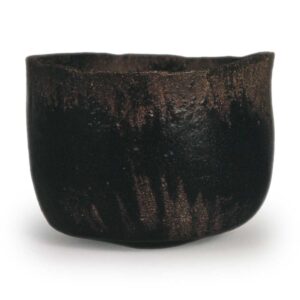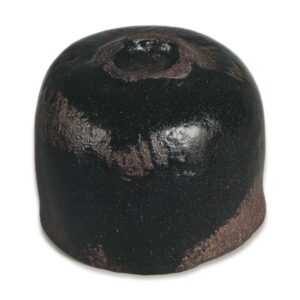

Important Cultural Property
Height: 8.8cm
Mouth diameter: 11.7-21.3cm
Bottom diameter: 6.1cm
The inscription “Rain Clouds” is thought to have been made to resemble a heavy shower of rain clouds in the view between the fire and the glaze.
Shigure, rain cloud, Tekkabe, and Shichiri have been highly valued as black raku tea bowls by Koetsu since ancient times, and among them, Tekkabe and Shichiri are the same shape, and Shigure and rain cloud are the common style. Unfortunately, Tekkabe was destroyed by fire in the Great Taisho Earthquake of 1923. There are one or two other black tea bowls of the same shape as Shichiri, but Shigure and Amegumo are the only two tea bowls of the same shape known so far, and they can be said to be the original form of Koetsu as Raku ware tea bowls.
Like Shigure, Amegumo is a tea bowl with a very low base, but in the case of Shigure, it was carved out in a low but high base shape.
The shape of the round and strong waist, from the body to the mouth is almost the same as that of Shigure, but while Shigure’s shape from the body to the top is generally a little tighter, Ameun’s shape is a little narrower at the mouth edge of only one side, and the mouth rim is slightly warped at the edge.
The mouth rim has a strong sinking horizontal shadow, as if it had been cut out flat, but the drizzle is not as strong as this, and is more quietly carved out. In addition, it is particularly impressive that the mouth is gently elevated.
Except for the inner and outer sides of the mouth and some parts of the body, waist, and the base, the glaze is thickly covered with kuroraku glaze, and the glazed surface is well melted and jet-black in color, probably because it was fired at a very high temperature. The most distinctive feature of the glazed scene is the slightly oblique fire spaces that appear on the sides of the mouth and hem of the body, as if they were rain clouds, and the uneven and varied scene is unique.
The unglazed part of the ware looks as if it has an iron skin, but there are two theories among the experts today as to whether this so-called “fire gap” was created by the natural scattering of glaze in the kiln or whether it was consciously created from the beginning. Among potters, Raku Kichizaemon believes that they were spontaneously scattered, while Yamada Sogo, a skilled copyist of Koetsu, thinks that they were artificially scraped off.
As for the rain clouds, both theories are possible, but in the case of Shigure, they were probably scattered in the kiln. If the fire space in the rain cloud was artificially scraped off, it would be a very artificial glaze, but the fire space around the waist on one side and the fire space on the side of the high table on the other side seem a little too unintentional.
The overall thickness is thicker than that of Shigure, with some parts thicker and some parts thinner, and is not consistent. There are no tea pits in the prospective area, and it is similar to other Koetsu teacups in that it is carved out in a wide and large area.
There is a crack from the mouth rim to the body.
On the back of the lid of the paulownia wood inner box, there are inscriptions of “Koetsu black tea bowl inscribed by Ameunza (hanaoshi)” and “Black Koetsu tea bowl with calligraphy by Sen Soza Kakusai Haraso” on the front of the lid, the author of the inscription is unknown.
The author of the inscription on the cover, “Black Koetsu tea bowl with calligraphy by Haraso Soza,” is unknown.
(Haruzo Hayashiya)



